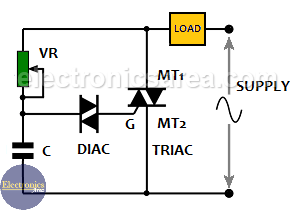Home / Semiconductors /
TRIAC. Power control on alternating current (AC)
Triac is a semiconductor device that belongs to the family of thyristor control devices. It is essentially two SCR connected in parallel and backwards, sharing the same gate. (See the diagram). It is only used with alternating current and like the SCR, it is triggered by the gate.
How does a TRIAC work?
It works with alternating current, so there will be one part of the wave that is positive and one negative. The positive part of the wave passes through the triac as long as there is a triggering signal on the gate, so the current flows from top to bottom (The current passes through the SCR going downwards)
On the same way, the negative part of the wave passes through the triac as long as the triggering signal is applies to the gate, so the current flows from bottom to top going upwards. In both cases the triggering signal is obtained from the same pin (the gate).
TRIAC symbol and equivalent circuit
It is possible to control the moment the TRIAC is triggered (the moment the signal is applied to the gate) and the time each SCR is ON. (Remember that a SCR is ON only when it has been triggered (activated) and there is a minimum positive voltage between anode 1 and anode 2 for each SCR.
Then, if we can control the time that each SCR is ON, it is possible to control the current that is delivered to a load and therefore the power consumed.
A Triac Application
A very common application is the incandescent lamp dimmer (a phase control circuit).
Where:
- Vin (supply): the applied voltage to the circuit (AC)
- VR: potentiometer
- C: capacitor
- MT1: anode # 1
- MT2: anode # 2
- G: Gate
- Load: incandescent light bulb
Triac controls the flow of the alternating current that passes through the lamp (load), changing continuously between the “on” state and the “cut off” state.
Moving the potentiometer knob, change the charging time of the capacitor, increasing or decreasing the phase difference between the power supply voltage and the voltage applied to the gate.
Note: the phase difference between two signals is the angle (time difference) between the signals when they cross the x axis (the time axis).




Can we reduce power consumption by dimming the lamp with this circuit ??
Hello Piyush
Yes. you can.
Regards